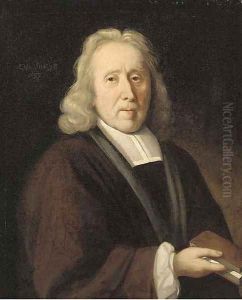Jacob Van Oost II Paintings
Jacob Van Oost the Younger was a Flemish Baroque painter born in 1637 in Bruges, which was then part of the Spanish Netherlands. He was the son of the prominent painter Jacob Van Oost the Elder, under whom he likely received his initial artistic training. This familial apprenticeship was a common practice in the artist guilds of the time, allowing skills and techniques to be passed down and preserved within families. The Van Oost family was well-respected and successful in the realm of painting, and Jacob II was to continue this legacy.
While not as widely recognized as his father, Jacob II developed his own artistic career and became known for his portraits and religious works. He is often distinguished from his father by the quality of his work, which, while skilled, is generally considered to be less refined than that of Jacob I. Despite this, he was a proficient painter, and his works were commissioned by local churches and members of the middle class in Bruges.
Jacob II's style was heavily influenced by the Baroque movement, which was characterized by dramatic expressions, strong contrasts of light and shadow, and a focus on realism and emotional intensity. His work reflects the Baroque interest in depicting human emotion and in using light to heighten the drama of religious scenes and portraits.
Details about his personal life and career are less documented than those of his father. However, it is known that he was a member of the Guild of Saint Luke, the association of artists and artisans in the city, which was typical for painters of the era. Jacob Van Oost the Younger worked primarily in Bruges and is believed to have remained there for the majority of his life.
Jacob Van Oost II died in 1713 in Bruges. His contributions to art are often overshadowed by those of his father, but he remains a notable figure within the context of Flemish Baroque painting. Although many of his works may have been lost or remain unrecognized, those that survive continue to be studied for their representation of the period's artistic trends and techniques.
